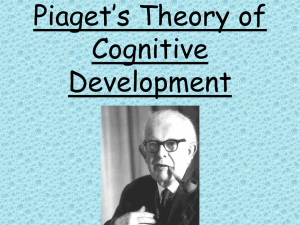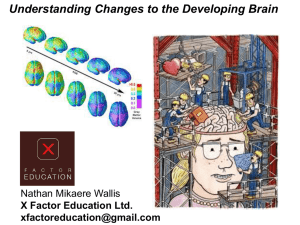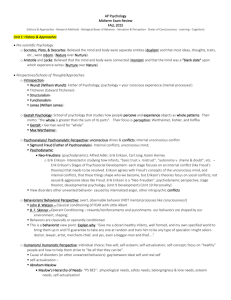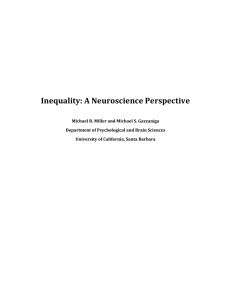Cognitive and Linguistic Development
advertisement
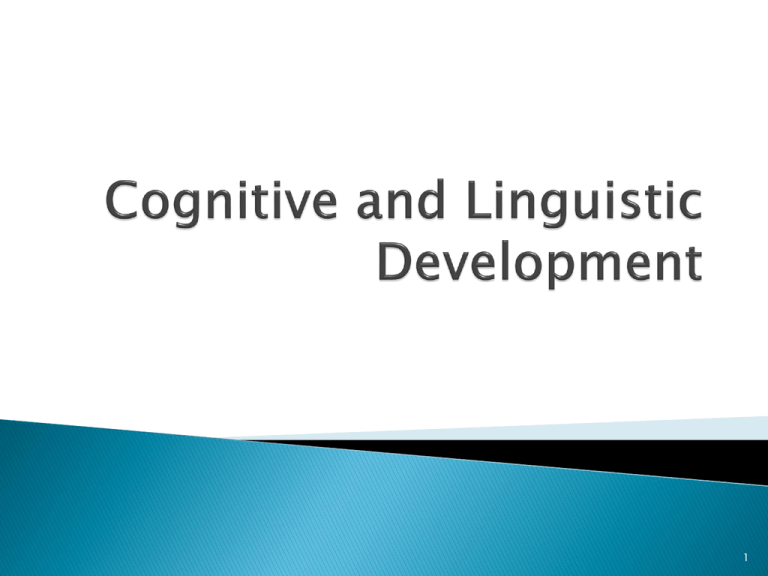
1 2 Role of the brain in advancing cognitive development ◦ Neurons and synapses 3 Dendrites Cell body ◦ Nucleus Axon ◦ Myelin sheath Axon terminals Synapse 4 What is the function of dendrites, axons, and axon terminals? How might lesser amounts of myelin affect neuronal transmission? ◦ What would be the effect on cognition? 5 6 Hindbrain ◦ Medulla ◦ Pons ◦ Cerebellum Midbrain ◦ Reticular formation Forebrain ◦ ◦ ◦ ◦ ◦ ◦ Thalamus Hypothalamus Limbic system Amygdala Hippocampus Cerebral cortex 7 Hemispheres ◦ Corpus callosum Lateralization or specialization 8 Lobes ◦ ◦ ◦ ◦ Frontal Parietal Temporal Occipital Specialty Areas ◦ Somatosensory cortex ◦ Motor cortex ◦ Wernicke’s area ◦ Broca’s area ◦ Auditory cortex ◦ Visual cortex 9 10 With learning ◦ Changes in neurons and synapses occur With development ◦ Complex thought increases ◦ More efficient use of memories Neuroplasticity 11 Describe the major functions of the frontal, parietal, temporal, and occipital lobes. How might research have been used to foster the development of left-brain and right-brain curricula and materials? ◦ Do these materials seem valid? ◦ How can you be sure you are using research supported techniques and materials? 12 13 Assumptions Maturation underlies development Children are active and curious Interaction with the environment is essential Complex thought emerges through process of equilibration ◦ Cognitive development progresses through stages ◦ ◦ ◦ ◦ 14 Processes ◦ ◦ ◦ ◦ ◦ Schemas Adaptation Assimilation Accommodation Equilibration Equilibrium and disequilibrium 15 Age range: Birth–2 years Characteristics: ◦ Learning through five senses ◦ Move from reflexes to goal directed actions ◦ Object permanence ◦ Symbolic thought 16 Age range: 2—7 years old Characteristics ◦ Lack operations ◦ Language develops Characteristics ◦ Intuitive thought ◦ Difficulty with centering and conservation ◦ Egocentrism 17 18 Age range: 7—11 years old Characteristics ◦ ◦ ◦ ◦ ◦ Perform concrete operations or “hands on” thinking Reversibility Logical thinking emerges Conservation Develop seriation, transitivity, and classification 19 Seriation Transitivity 20 Age range: 11—15 years old Characteristics ◦ “Scientific” reasoning ◦ Hypothetico-deductive reasoning ◦ Adolescent egocentrism Imaginary audience Personal fable ◦ Not all individuals reach this stage 21 Limitations •Stage theory inconsistencies •Underestimation of preschool children’s abilities •Overestimation of adolescents’ abilities •No discussion of cultural impacts 22 Changes from one stage to the next are less consistent and global than Piaget suggested. Children are not always egocentric. Children’s knowledge and mental strategies develop at different ages in different areas. Cognitive development as changing frequencies in children’s use of different ways of thinking, not sudden, permanent shifts from one way of thinking to another. 23 Correct in that children’s thinking becomes more systematic, consistent, and integrated as they get older. Children now viewed as active explorers and constructors of knowledge. ◦ Not passive recipients of input from environment. Inspired others to experimentally test his findings and theories. 24 Learning is an active process ◦ Children actively explore and construct their own knowledge. ◦ Learning should take place in an authentic, meaningful situations instead of isolated skills Thinking becomes more systematic and integrated over time ◦ Consider the cognitive stage of students with respect to presentation strategies, examples, and assignments Use disequilibrium to motivate Use social interactions 25 Discuss the major assumptions underlying Piaget’s theory. Describe the major characteristics of Piaget’s four stages of cognitive development. The best way to determine a student’s current level of cognitive development is to watch him/her solve a problem. Why is this so? How can Piaget’s concepts and theory assist you in the classroom on a day-to-day basis? 26 27 Assumptions ◦ Children actively construct knowledge ◦ Origin of higher mental processes is social interaction ◦ Culture provides tools for learning ◦ Language is integral in cognitive development and learning ◦ Children can perform beyond their ability levels when given help ◦ Children should be challenged to promote cognitive development 28 Processes ◦ ◦ ◦ ◦ Zone of proximal development Scaffolding Co-construction of knowledge Language 29 Theoretical space between tasks children can perform independently and more challenging tasks which children can perform with assistance 30 Guidance and support needed for cognitive development to proceed Provided by more competent peer or adult Typically provided through the use of language 31 Knowledge is first encountered in shared activities with a more skilled partner Knowledge gained from social interaction is internalized 32 Cultural tool Guides thinking and learning Private speech 33 Collaborative and assisted learning ◦ Utilize activities requiring language, especially dialogue Scaffolding Individualized instruction ◦ Allow all students to experience success at challenging tasks Alternative assessment Self-regulation ◦ Consistent implementation of rules and consequences ◦ Work toward and achieve goals 34 Describe the basic assumptions underlying Vygotsky’s theory. Compare and contrast Piaget and Vygotsky’s theories. ◦ How can both theories be helpful to teachers in understanding and furthering the cognitive development of their students? 35 36 Based on computer metaphor ◦ ◦ ◦ ◦ Cognition is the software Encoding Storage Retrieval 37 38 The five senses Sensory register Capacity: large Duration: brief Contents Roles of attention and perception 39 Bottom-up processing Top-down processing The role of attention Automaticity 40 41 42 Must have students’ attention ◦ Use signals Make purpose of lesson/assignment clear Discuss value of assignment Use variety and capitalize on curiosity Developmental differences 43 Distinction between short term memory (STM) and working memory (WM) Capacity: 5 to 9 separate items Duration: 5 to 20 seconds 3 Components of Working Memory ◦ Central executive ◦ Articulatory loop rehearsal system ◦ Visuospatial sketchpad 44 Rehearsal can increase duration ◦ Maintenance rehearsal ◦ Elaborative rehearsal ◦ Chunking Forgetting ◦ Interference ◦ Decay 45 Storage takes more time & effort Capacity: unlimited Duration: unlimited Contains visual or verbal or a combination of codes Retrieval may be troublesome 46 47 Gradual quantitative changes in children’s mental capabilities With maturation and experience: ◦ Information-processing skills improve ◦ Attention spans increase ◦ Memory storage capacity improves 48 Most children remember autobiographical memories from age 5 or 6 Few children remember anything from before age of 3 Why do children experience “infantile amnesia”? ◦ Young children lack necessary processes for memory encoding and storage? ◦ Children have yet to develop a sense of self? 49 Other possible explanations: ◦ Early memories are implicit, not explicit. ◦ Early memories are lost due to the lack of language skills to talk about, and solidify, those memories. ◦ Specific events may be difficult to remember because of “generalized event representations.” 50 Describe the major functions of the sensory, working, and long-term memories. ◦ How can you as a teacher use this information to further your students’ intellectual development? How can information regarding top-down and bottom-up processing help students to better solve problems? 51 52 1. 2. 3. 4. 5. 6. All learning is physiological. The Brain-Mind is social. The search for meaning is innate. The search for meaning occurs through patterning. Emotions are critical to patterning. The Brain-Mind processes parts and wholes simultaneously. Learning involves both focused attention and peripheral perception. 8. Learning always involves conscious and unconscious processes. 9. There are at least two approaches to memory: archiving individual facts or skills or making sense of experience. 10. Learning is developmental. 11. Complex learning is enhanced by challenge and inhibited by threat associated with helplessness. 12. Each brain is uniquely organized 7. 53 Brains are not passive receptors of information. Brains are doing things even when they don't seem to be. Behavior can be "released", rather than only "caused." Acting ("output") changes experience ("input"). The same input can result in different experiences. Effective systems can be distributed rather than hierarchical. 54 Such systems depend on effective communication, both talking and listening. Expect changes to take time/persistence. Knowledge is NOT dangerous, but it does not guarantee security and is always incomplete. What one sees is not necessarily what's out there. Reality is a hypothesis; the brain is designed to continually check and revise it by looking at things from additional perspectives. 55 Enrich the cortex ◦ Provide steady source of positive emotional support - love, encouragement, warmth and caring. ◦ Our old rats live longer with tender loving care. Provide a nutritious diet with enough protein, vitamins, minerals and calories. ◦ Low protein diets during development diminish the capability of branches on the nerve cells in the cortex to respond to enriched conditions. Stimulate all the senses, but not necessarily all at once. 56 Provide an atmosphere free of undue pressure and stress but suffused with a degree of pleasurable intensity. Present a series of novel challenges that are neither too easy nor too difficult for the child at his or her stage of development Allow for social interaction for a significant percentage of activities. Promote the development of a broad range of skills and interests that are mental, physical, aesthetic, social and emotional 57 Give the child an opportunity to choose many activities. ◦ Allow each unique brain to choose. Give the child a chance to assess the results of efforts and to modify them. Promote exploration and the fun of learning. ◦ Rats living in enriched environments are more exploratory than those living in impoverishment. Allow the child to be an active participant rather than a passive observer 58 A vacillating or negative emotional climate. A diet low in protein, vitamins, and minerals, and too high or too low in calories. Sensory deprivation. High levels of stress and pressure. Unchanging conditions lacking in novelty. 59 Long periods of isolation from caregivers and/or peers. A heavy, dull atmosphere lacking in fun or in a sense of exploration and the joy of learning. A passive, rather than active involvement in some or all activities. Little personal choice of activities. Little chance to evaluate results or effects and change to different activities. Development in a narrow, not panoramic, range of interests. 60 Listen more to other teachers, plan using their experience Educate/involve parents more Create sense of parent/teacher partnership in dealing with problems no one knows exactly how to solve Provide more prenatal education to parents Provide new education for teachers Provide teachers with current information about, usable resources for dealing with various forms of "learning disabilities" 61 62 Definition Language contains ◦ Phonemes ◦ Morphemes ◦ Grammar Syntax Semantics 63 Prelinguistic stage ◦ Crying ◦ Cooing ◦ Babbling Linguistic stage ◦ Single utterances ◦ Telegraphic speech ◦ Learning rules of grammar 64 Nature or nurture or both? ◦ Is language reinforced behaviors or do humans have a special capacity for language learning? Influences of heredity and environment 65 Pronunciation Syntax Vocabulary and meaning Comprehension Metalinguistic awareness Pragmatics 66 Describe how language develops. Describe the different components of language. How can you as a teacher foster language development in your classroom? Is the ability to use language unique to human beings? Explain your response. ◦ If chimpanzees have been taught to use sign language much like hearing impaired humans, are they both in fact using language? Explain your response. 67 68




